TOYOTA CAMRY V20 1986 Service Information
Manufacturer: TOYOTA, Model Year: 1986, Model line: CAMRY V20, Model: TOYOTA CAMRY V20 1986Pages: 2389, PDF Size: 84.44 MB
Page 1161 of 2389
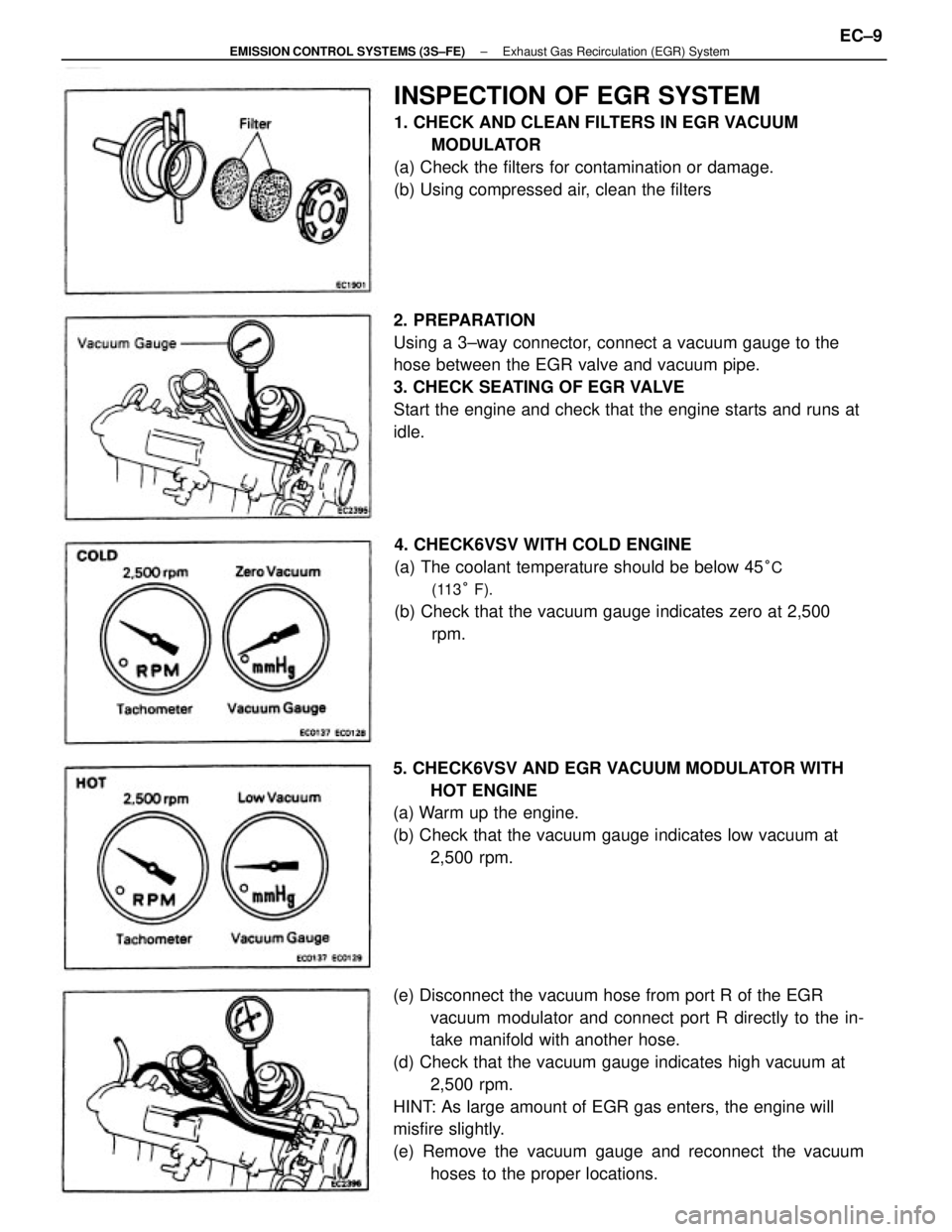
(e) Disconnect the vacuum hose from port R of the EGR
vacuum modulator and connect port R directly to the in-
take manifold with another hose.
(d) Check that the vacuum gauge indicates high vacuum at
2,500 rpm.
HINT: As large amount of EGR gas enters, the engine will
misfire slightly.
(e) Remove the vacuum gauge and reconnect the vacuum
hoses to the proper locations. 2. PREPARATION
Using a 3±way connector, connect a vacuum gauge to the
hose between the EGR valve and vacuum pipe.
3. CHECK SEATING OF EGR VALVE
Start the engine and check that the engine starts and runs at
idle.
5. CHECK6VSV AND EGR VACUUM MODULATOR WITH
HOT ENGINE
(a) Warm up the engine.
(b) Check that the vacuum gauge indicates low vacuum at
2,500 rpm.
INSPECTION OF EGR SYSTEM
1. CHECK AND CLEAN FILTERS IN EGR VACUUM
MODULATOR
(a) Check the filters for contamination or damage.
(b) Using compressed air, clean the filters
4. CHECK6VSV WITH COLD ENGINE
(a) The coolant temperature should be below 45
°C
(113° F).
(b) Check that the vacuum gauge indicates zero at 2,500
rpm.
± EMISSION CONTROL SYSTEMS (3S±FE)Exhaust Gas Recirculation (EGR) SystemEC±9
Page 1162 of 2389
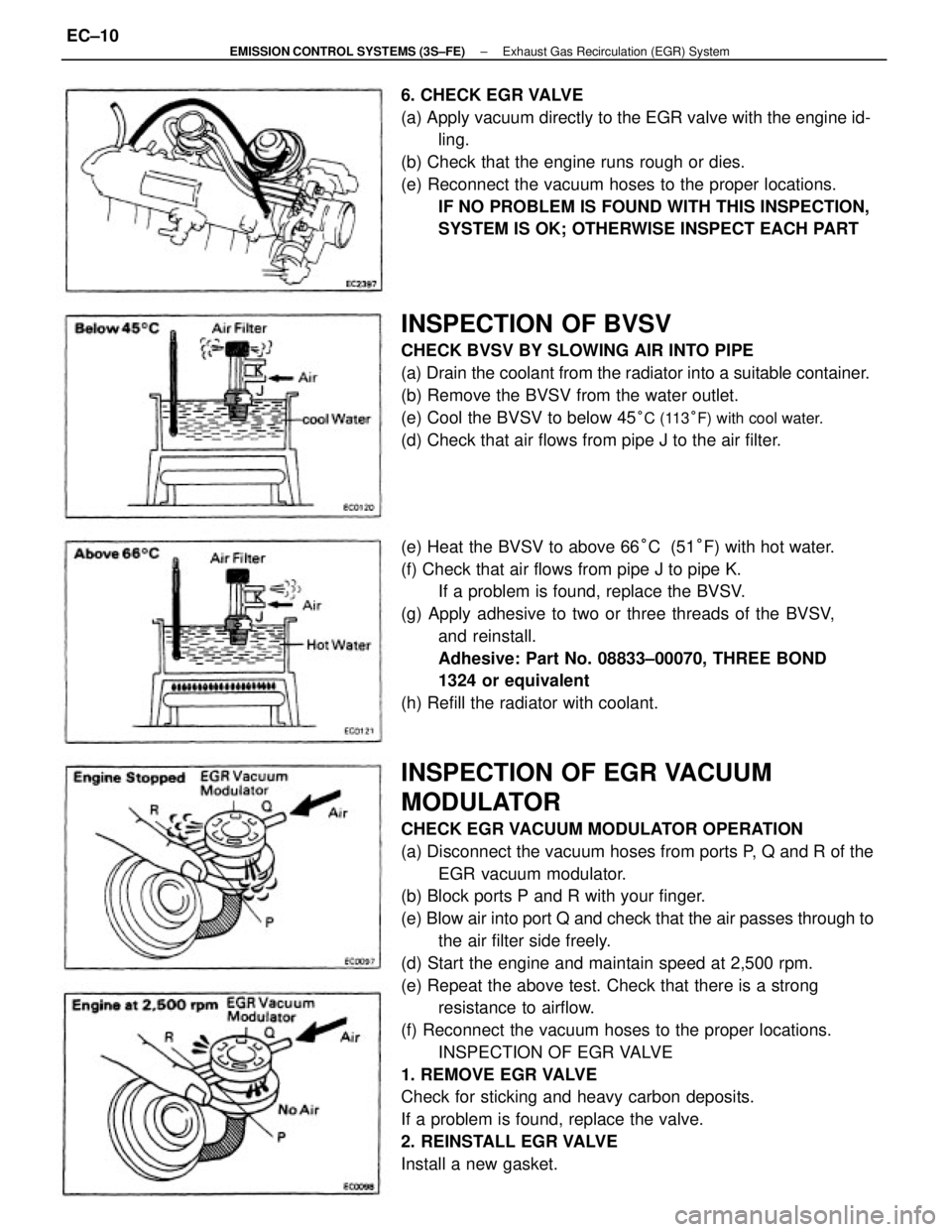
INSPECTION OF EGR VACUUM
MODULATOR
CHECK EGR VACUUM MODULATOR OPERATION
(a) Disconnect the vacuum hoses from ports P, Q and R of the
EGR vacuum modulator.
(b) Block ports P and R with your finger.
(e) Blow air into port Q and check that the air passes through to
the air filter side freely.
(d) Start the engine and maintain speed at 2,500 rpm.
(e) Repeat the above test. Check that there is a strong
resistance to airflow.
(f) Reconnect the vacuum hoses to the proper locations.
INSPECTION OF EGR VALVE
1. REMOVE EGR VALVE
Check for sticking and heavy carbon deposits.
If a problem is found, replace the valve.
2. REINSTALL EGR VALVE
Install a new gasket.
INSPECTION OF BVSV
CHECK BVSV BY SLOWING AIR INTO PIPE
(a) Drain the coolant from the radiator into a suitable container.
(b) Remove the BVSV from the water outlet.
(e) Cool the BVSV to below 45
°C (113°F) with cool water.
(d) Check that air flows from pipe J to the air filter.
(e) Heat the BVSV to above 66°C (51°F) with hot water.
(f) Check that air flows from pipe J to pipe K.
If a problem is found, replace the BVSV.
(g) Apply adhesive to two or three threads of the BVSV,
and reinstall.
Adhesive: Part No. 08833±00070, THREE BOND
1324 or equivalent
(h) Refill the radiator with coolant. 6. CHECK EGR VALVE
(a) Apply vacuum directly to the EGR valve with the engine id-
ling.
(b) Check that the engine runs rough or dies.
(e) Reconnect the vacuum hoses to the proper locations.
IF NO PROBLEM IS FOUND WITH THIS INSPECTION,
SYSTEM IS OK; OTHERWISE INSPECT EACH PART
± EMISSION CONTROL SYSTEMS (3S±FE)Exhaust Gas Recirculation (EGR) SystemEC±10
Page 1163 of 2389
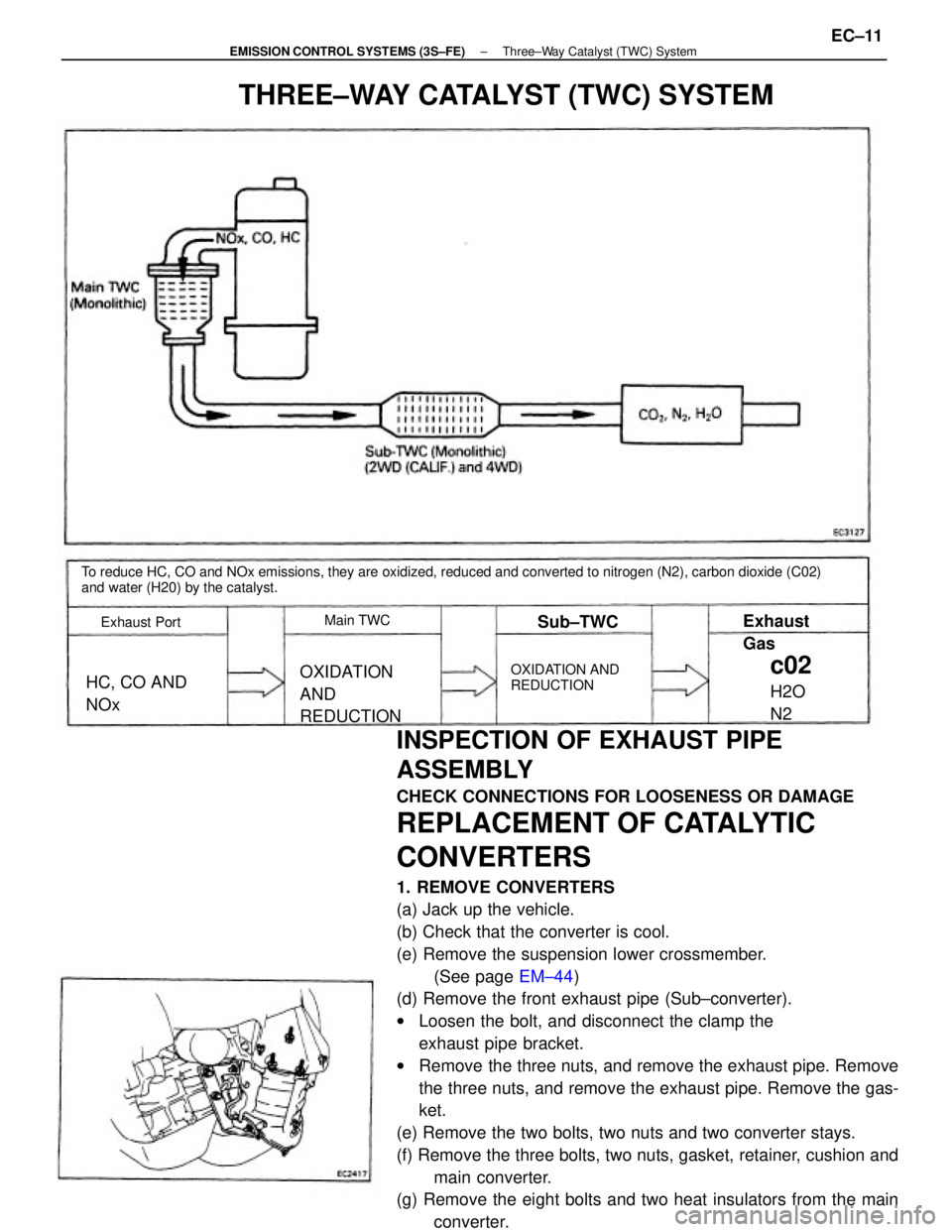
INSPECTION OF EXHAUST PIPE
ASSEMBLY
CHECK CONNECTIONS FOR LOOSENESS OR DAMAGE
REPLACEMENT OF CATALYTIC
CONVERTERS
1. REMOVE CONVERTERS
(a) Jack up the vehicle.
(b) Check that the converter is cool.
(e) Remove the suspension lower crossmember.
(See page EM±44)
(d) Remove the front exhaust pipe (Sub±converter).
wLoosen the bolt, and disconnect the clamp the
exhaust pipe bracket.
wRemove the three nuts, and remove the exhaust pipe. Remove
the three nuts, and remove the exhaust pipe. Remove the gas-
ket.
(e) Remove the two bolts, two nuts and two converter stays.
(f) Remove the three bolts, two nuts, gasket, retainer, cushion and
main converter.
(g) Remove the eight bolts and two heat insulators from the main
converter.
To reduce HC, CO and NOx emissions, they are oxidized, reduced and converted to nitrogen (N2), carbon dioxide (C02)
and water (H20) by the catalyst.
THREE±WAY CATALYST (TWC) SYSTEM
OXIDATION
AND
REDUCTIONOXIDATION AND
REDUCTIONHC, CO AND
NOx
Exhaust Port
c02
H2O
N2 Exhaust
Gas
Main TWCSub±TWC
± EMISSION CONTROL SYSTEMS (3S±FE)Three±Way Catalyst (TWC) SystemEC±11
Page 1164 of 2389
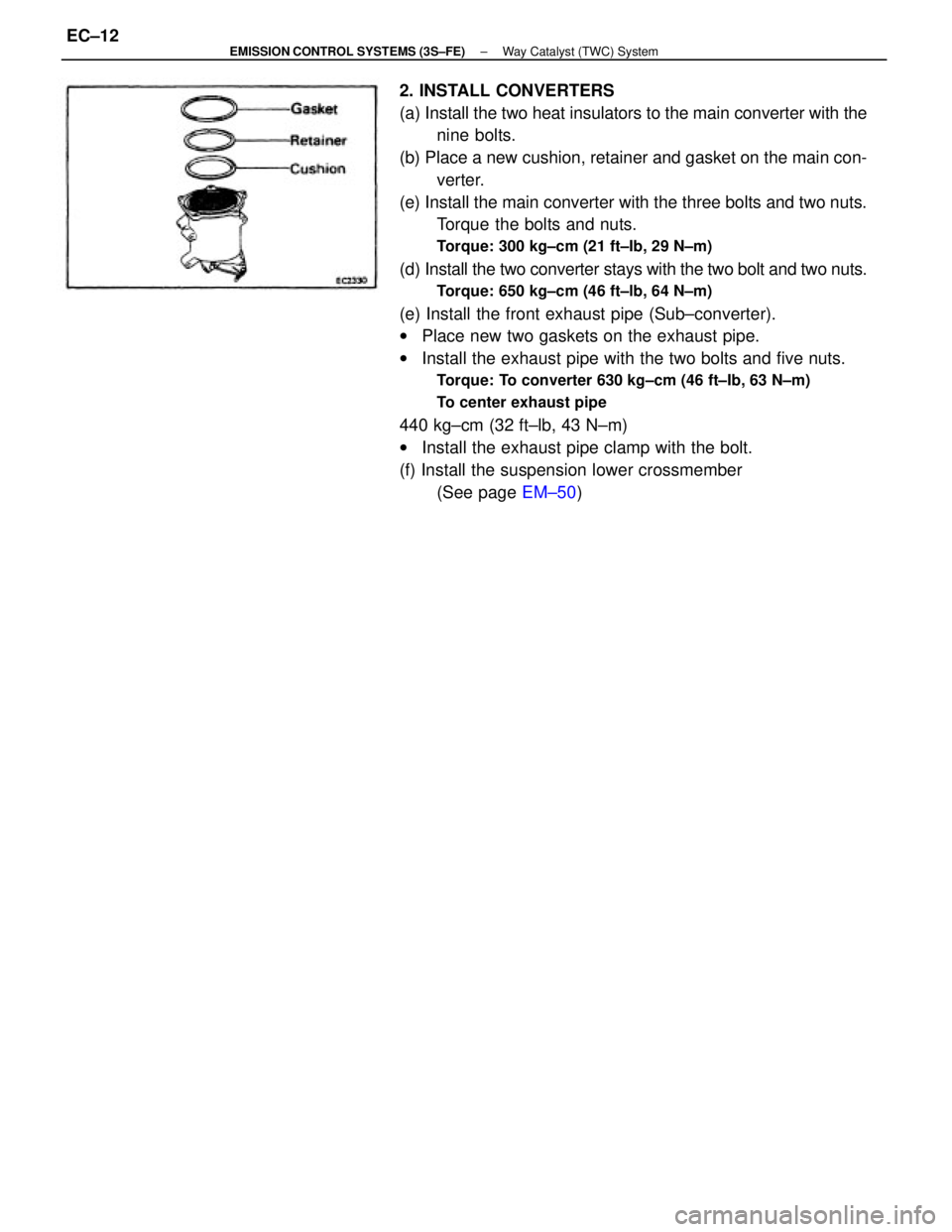
2. INSTALL CONVERTERS
(a) Install the two heat insulators to the main converter with the
nine bolts.
(b) Place a new cushion, retainer and gasket on the main con-
verter.
(e) Install the main converter with the three bolts and two nuts.
Torque the bolts and nuts.
Torque: 300 kg±cm (21 ft±Ib, 29 N±m)
(d) Install the two converter stays with the two bolt and two nuts.
Torque: 650 kg±cm (46 ft±lb, 64 N±m)
(e) Install the front exhaust pipe (Sub±converter).
wPlace new two gaskets on the exhaust pipe.
wInstall the exhaust pipe with the two bolts and five nuts.
Torque: To converter 630 kg±cm (46 ft±Ib, 63 N±m)
To center exhaust pipe
440 kg±cm (32 ft±lb, 43 N±m)
wInstall the exhaust pipe clamp with the bolt.
(f) Install the suspension lower crossmember
(See page EM±50)
± EMISSION CONTROL SYSTEMS (3S±FE)Way Catalyst (TWC) SystemEC±12
Page 1165 of 2389
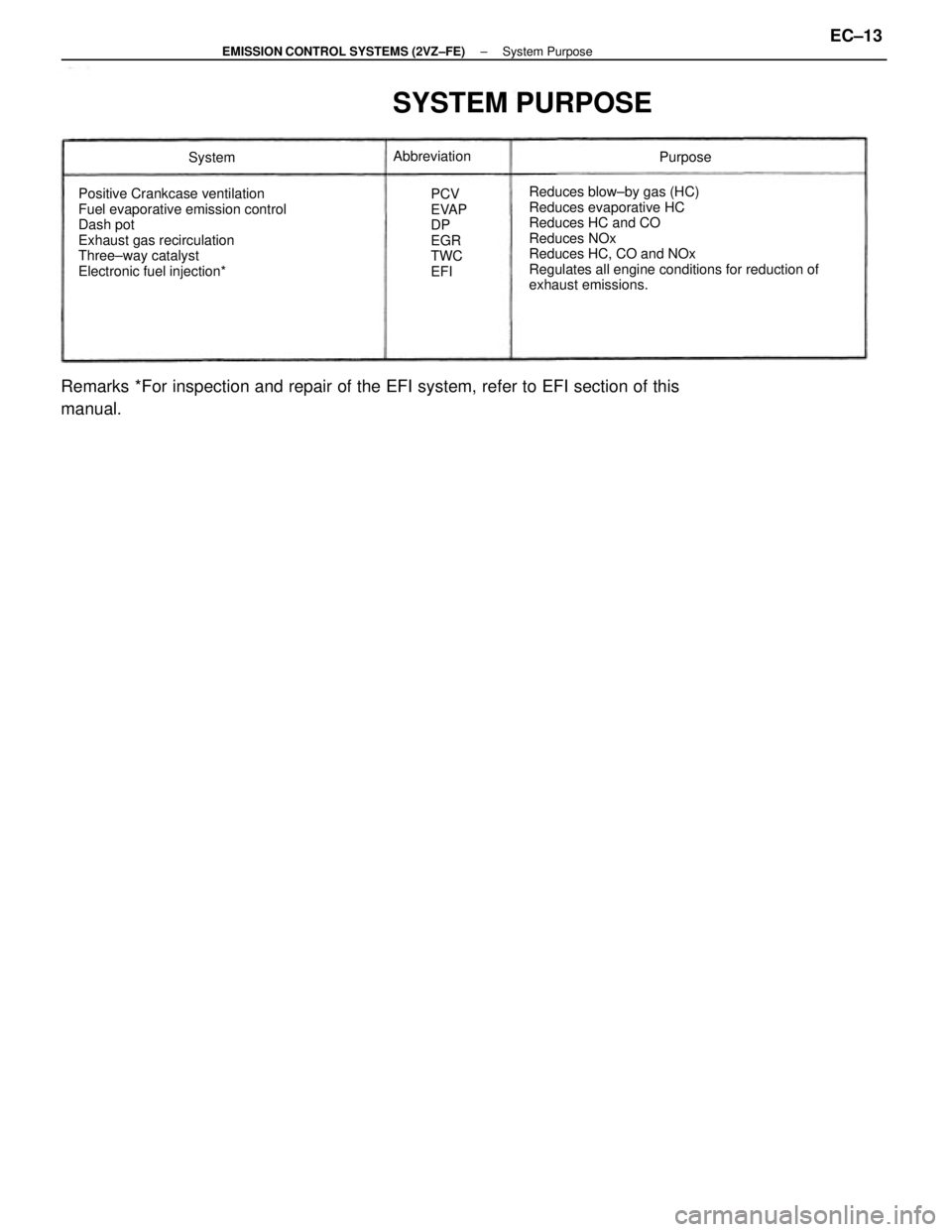
Reduces blow±by gas (HC)
Reduces evaporative HC
Reduces HC and CO
Reduces NOx
Reduces HC, CO and NOx
Regulates all engine conditions for reduction of
exhaust emissions. Positive Crankcase ventilation
Fuel evaporative emission control
Dash pot
Exhaust gas recirculation
Three±way catalyst
Electronic fuel injection*
Remarks *For inspection and repair of the EFI system, refer to EFI section of this
manual.
SYSTEM PURPOSE
PCV
EVAP
DP
EGR
TWC
EFI Abbreviation
Purpose
System
± EMISSION CONTROL SYSTEMS (2VZ±FE)System PurposeEC±13
Page 1166 of 2389
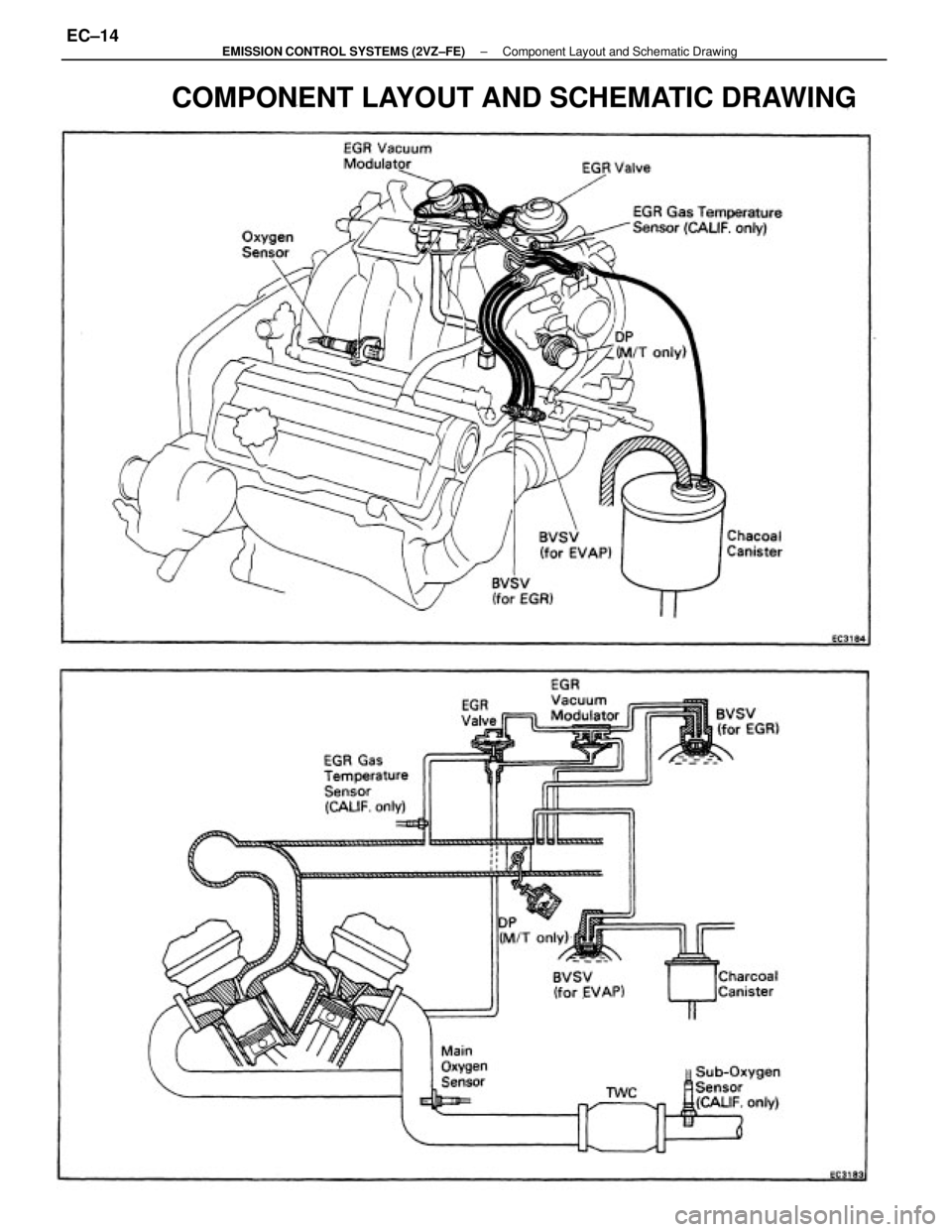
COMPONENT LAYOUT AND SCHEMATIC DRAWING
± EMISSION CONTROL SYSTEMS (2VZ±FE)Component Layout and Schematic DrawingEC±14
Page 1167 of 2389
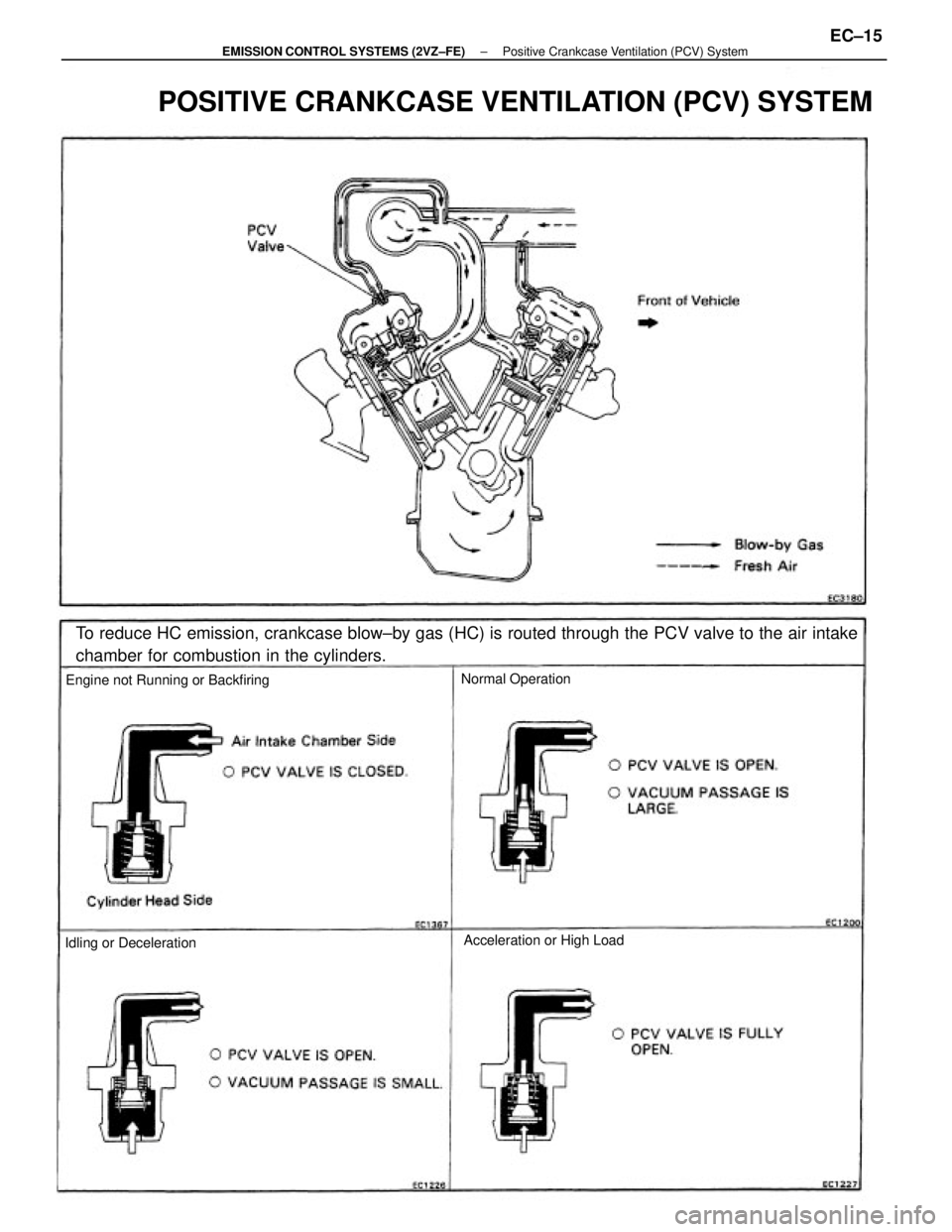
POSITIVE CRANKCASE VENTILATION (PCV) SYSTEM
To reduce HC emission, crankcase blow±by gas (HC) is routed through the PCV valve to the air intake
chamber for combustion in the cylinders.
Engine not Running or Backfiring
Acceleration or High Load
Idling or DecelerationNormal Operation
± EMISSION CONTROL SYSTEMS (2VZ±FE)Positive Crankcase Ventilation (PCV) SystemEC±15
Page 1168 of 2389
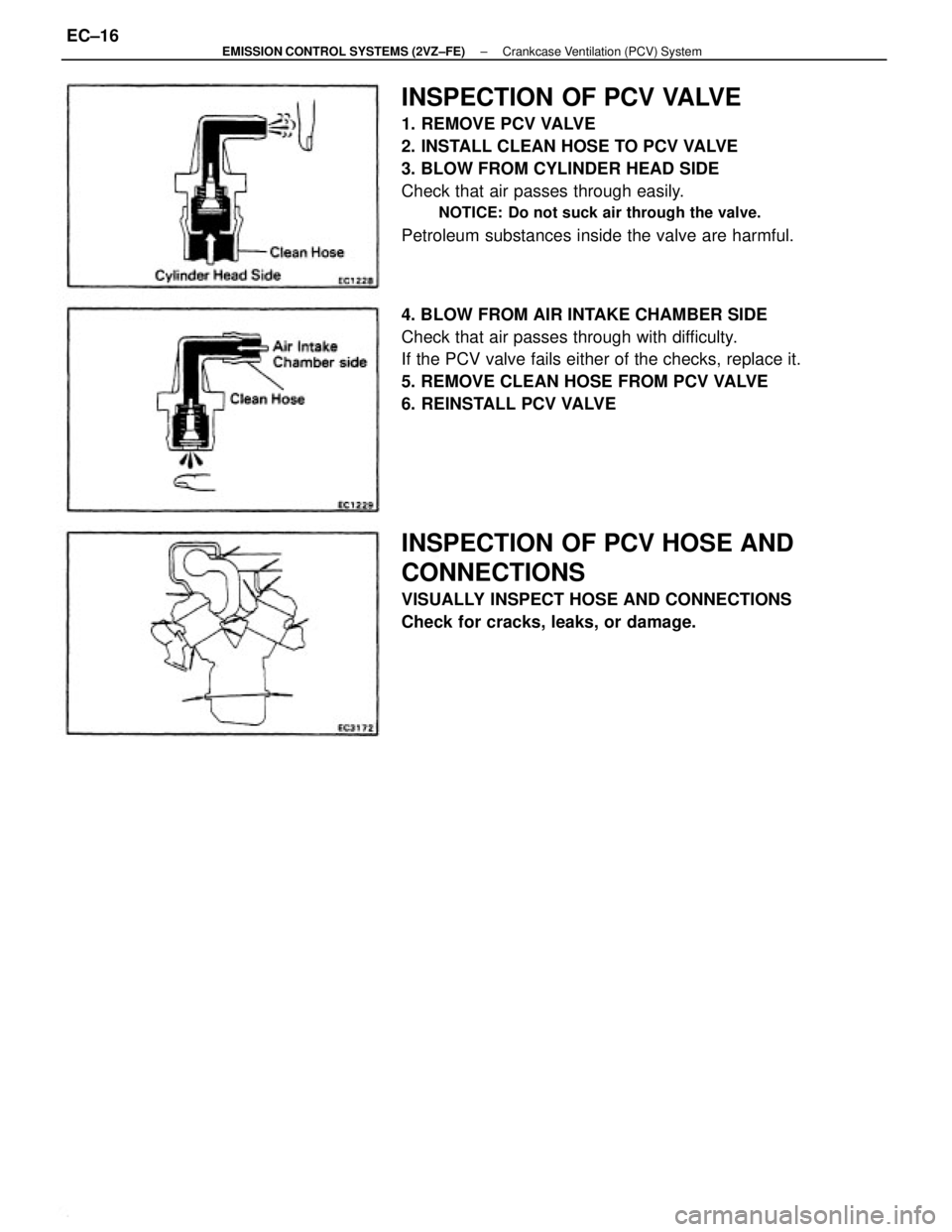
INSPECTION OF PCV VALVE
1. REMOVE PCV VALVE
2. INSTALL CLEAN HOSE TO PCV VALVE
3. BLOW FROM CYLINDER HEAD SIDE
Check that air passes through easily.
NOTICE: Do not suck air through the valve.
Petroleum substances inside the valve are harmful.
4. BLOW FROM AIR INTAKE CHAMBER SIDE
Check that air passes through with difficulty.
If the PCV valve fails either of the checks, replace it.
5. REMOVE CLEAN HOSE FROM PCV VALVE
6. REINSTALL PCV VALVE
INSPECTION OF PCV HOSE AND
CONNECTIONS
VISUALLY INSPECT HOSE AND CONNECTIONS
Check for cracks, leaks, or damage.
± EMISSION CONTROL SYSTEMS (2VZ±FE)Crankcase Ventilation (PCV) SystemEC±16
Page 1169 of 2389
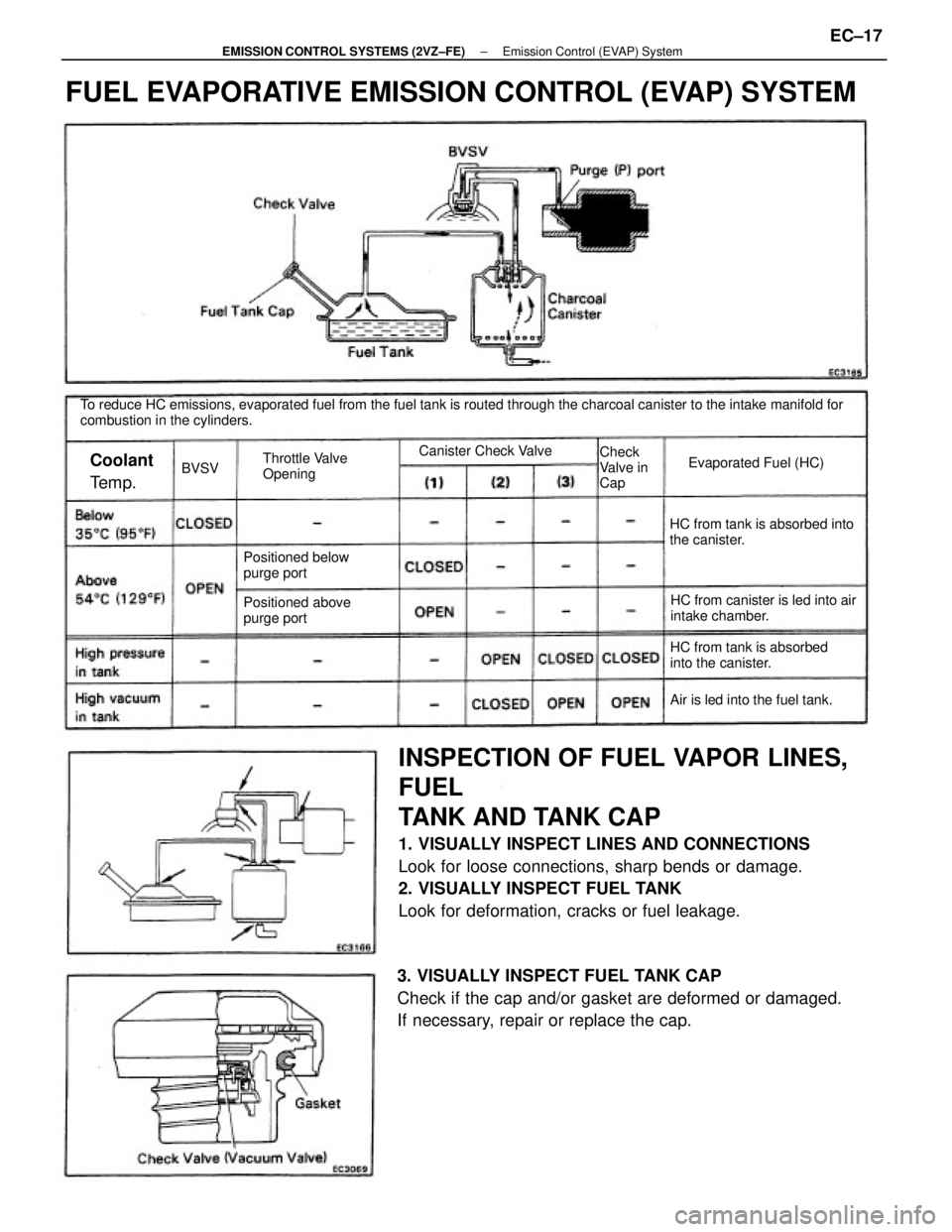
INSPECTION OF FUEL VAPOR LINES,
FUEL
TANK AND TANK CAP
1. VISUALLY INSPECT LINES AND CONNECTIONS
Look for loose connections, sharp bends or damage.
2. VISUALLY INSPECT FUEL TANK
Look for deformation, cracks or fuel leakage.
To reduce HC emissions, evaporated fuel from the fuel tank is routed through the charcoal canister to the intake manifold for
combustion in the cylinders.
3. VISUALLY INSPECT FUEL TANK CAP
Check if the cap and/or gasket are deformed or damaged.
If necessary, repair or replace the cap.
FUEL EVAPORATIVE EMISSION CONTROL (EVAP) SYSTEM
HC from canister is led into air
intake chamber. HC from tank is absorbed into
the canister.
HC from tank is absorbed
into the canister. Positioned below
purge port
Positioned above
purge port
Air is led into the fuel tank. Throttle Valve
OpeningEvaporated Fuel (HC) Canister Check Valve
Check
Valve in
Cap
Coolant
Te m p .BVSV
± EMISSION CONTROL SYSTEMS (2VZ±FE)Emission Control (EVAP) SystemEC±17
Page 1170 of 2389
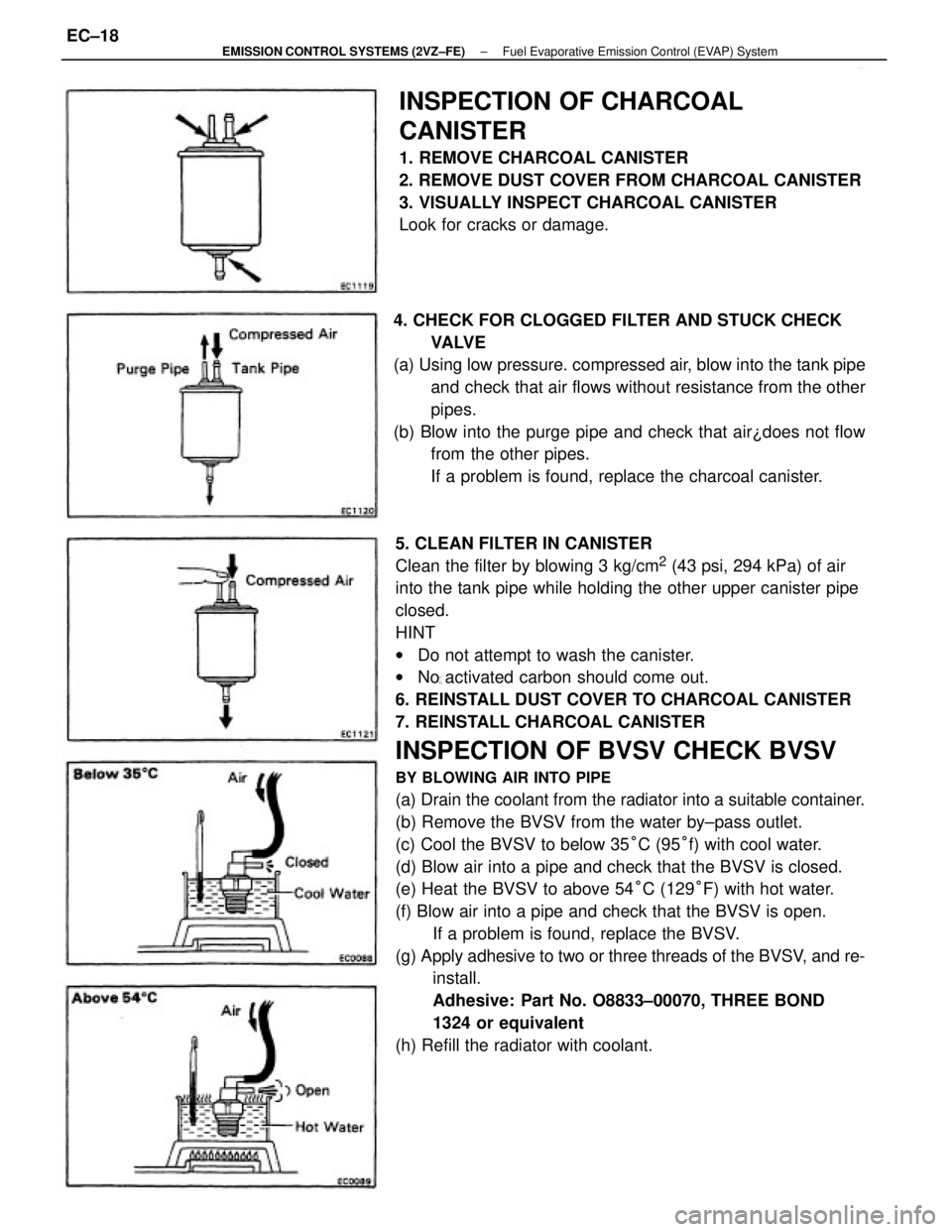
5. CLEAN FILTER IN CANISTER
Clean the filter by blowing 3 kg/cm
2 (43 psi, 294 kPa) of air
into the tank pipe while holding the other upper canister pipe
closed.
HINT
wDo not attempt to wash the canister.
wNo activated carbon should come out.
6. REINSTALL DUST COVER TO CHARCOAL CANISTER
7. REINSTALL CHARCOAL CANISTER
INSPECTION OF BVSV CHECK BVSV
BY BLOWING AIR INTO PIPE
(a) Drain the coolant from the radiator into a suitable container.
(b) Remove the BVSV from the water by±pass outlet.
(c) Cool the BVSV to below 35°C (95°f) with cool water.
(d) Blow air into a pipe and check that the BVSV is closed.
(e) Heat the BVSV to above 54°C (129°F) with hot water.
(f) Blow air into a pipe and check that the BVSV is open.
If a problem is found, replace the BVSV.
(g) Apply adhesive to two or three threads of the BVSV, and re-
install.
Adhesive: Part No. O8833±00070, THREE BOND
1324 or equivalent
(h) Refill the radiator with coolant.
INSPECTION OF CHARCOAL
CANISTER
1. REMOVE CHARCOAL CANISTER
2. REMOVE DUST COVER FROM CHARCOAL CANISTER
3. VISUALLY INSPECT CHARCOAL CANISTER
Look for cracks or damage.
4. CHECK FOR CLOGGED FILTER AND STUCK CHECK
VA LV E
(a) Using low pressure. compressed air, blow into the tank pipe
and check that air flows without resistance from the other
pipes.
(b) Blow into the purge pipe and check that air¿does not flow
from the other pipes.
If a problem is found, replace the charcoal canister.
± EMISSION CONTROL SYSTEMS (2VZ±FE)Fuel Evaporative Emission Control (EVAP) SystemEC±18